Installation Basics
Installation Basics
VERY IMPORTANT - THE FOLLOWING ARE GENERAL AND INFORMAL GUIDELINES FOR THE INSTALLATION OF STONE. IT IS NECESSARY TO VERIFY PROPER INSTALLATION METHODS ACCORDING TO PARTICULAR PROJECTS WITH THE STONE SUPPLIER, ADHESIVE MANUFACTURER AND INSTALLER. MARBLE AND GRANITE, INC. IS NOT RESPONSIBLE FOR ANY OMISSION OR MISUNDERSTANDING OF THESE GUIDELINES.
I. Material Handling
Tiles
Handling of tiles is fairly easy because tiles are usually sold packed in 10 per box and the weight of the box is approximately 60 lbs. One person should be able to carry one box of tiles, and if the floor permits, a two-wheeler will be helpful to move the stone. It is important that the tiles be standing vertically.

Handling of tiles is fairly easy because tiles are usually sold packed in 10 per box and the weight of the box is approximately 60 lbs. One person should be able to carry one box of tiles, and if the floor permits, a two-wheeler will be helpful to move the stone. It is important that the tiles be standing vertically.

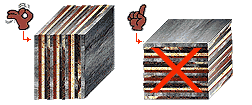
Slabs
Handling slabs is more complicated. When the pieces are large and heavy, slabs should be loaded and unloaded with the proper equipment, a forklift with boom or an overhead crane. If the marble or granite has a polished face, the slabs should be loaded vertically with the polished faces touching each other.
Handling slabs is more complicated. When the pieces are large and heavy, slabs should be loaded and unloaded with the proper equipment, a forklift with boom or an overhead crane. If the marble or granite has a polished face, the slabs should be loaded vertically with the polished faces touching each other.
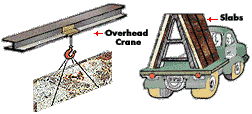
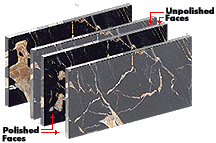
At the job site, the slabs must be carried in a vertical position.

II. Storage
When slabs are going to be stocked at the job site, the following precautions should be taken:
Slabs should be placed away from the job traffic area.
The polished sides should be facing each other.
Slabs should be resting vertically.
If it is necessary to stack them, the slabs should be separated by a 1"x4" piece of wood.
The polished sides should be facing each other.
Slabs should be resting vertically.
If it is necessary to stack them, the slabs should be separated by a 1"x4" piece of wood.
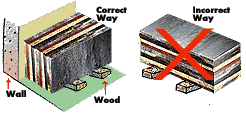

III. Sorting stone tiles before installation
Two very important steps have to be taken before installing the material:
1. Check Your Delivery: Verify that the correct material was delivered. Once the material is installed, it is too late to make any changes.
2. Sorting the Material for the Job: The success of a great marble job is the mixing and matching of the stone before installation. This step will always yield to a uniform homogeneous installation.
For proper stone placement or mixture, we recommend the following guidelines:
Divide the area of installation into separate flat areas and allocate enough material for each area including some waste.
If the material to be installed is tiles, all the boxes should be open and the tiles should be taken from all the boxes randomly. In this way, the installation will be uniform and the material will look homogeneous. Remember that stone cannot be inspected or appreciated by looking at just one tile. The only way to check stone is by looking at several tiles, mixing them and laying them flat together in order to appreciate the stone's quality and color.
If the material to be installed is tiles, all the boxes should be open and the tiles should be taken from all the boxes randomly. In this way, the installation will be uniform and the material will look homogeneous. Remember that stone cannot be inspected or appreciated by looking at just one tile. The only way to check stone is by looking at several tiles, mixing them and laying them flat together in order to appreciate the stone's quality and color.
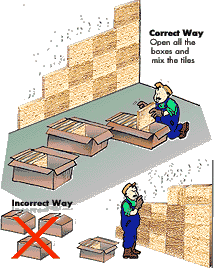
· The direction of the vein should be considered before starting installation.
· If there is not enough material to finish a complete section, the installation should not be started because it will be very likely that the additional material will have a different tone.
IV. Types of Installation
(Please note that these are general guidelines; you should check specifications from both the adhesive manufacturer and the building code.)
Stone tiles can be installed by adhesive or they can be mechanically anchored depending on the size of the pieces and the application. A different method and adhesive is used if tiles are going to be installed indoors versus outdoors.
The installation of slabs on fireplaces is recommended using mechanical anchors with adhesive for the vertical pieces.
When installing horizontal pieces for countertops, it is recommended to use a non-staining adhesive.
Joints between pieces should be grouted using the proper material and color. It is important to approve a sample of the grout before the job is done to avoid problems. The seams should be perfectly clean before applying the grout material.
V. Steps involved in a countertop installation
1. Sketch the countertops allowing for overhang on top of the cabinets. Include backsplashes and any cutout dimension. In addition, choose a finished edge for any visible edge of the countertop and backsplash. (See Edge table below). When sketching the countertops, take into account that the size availability of the slabs is approximately 102" x 62". Therefore, location of the seams is an important consideration.
2. With a sketch and material alternative, contact a few stone fabricators and ask them for a quote and delivery time. The quote should include prices for templates, fabrication, and installation.
3. Fabrication shops will require approximately 50% deposit to start the job. Before giving any payment, the customer should approve the material. When inspecting the material, one should consider variation, small imperfections in the stone, and particular markings on slabs. If there are concerns regarding the stone, the customer should try to see the actual stone to be used for their project. The customer should also know that stone is a natural material, so it has unique characteristics that cannot be changed.
4. Fabricators or installers will fabricate templates. In order to be able to make accurate templates, cabinets should already be installed and fixed. Accessories such as sinks, cook tops, faucets, dishwasher screws, and any other related hardware should be purchased and at the job site location prior to beginning templates.
5. Fabricators will cut the stone and finish the edges as per order. Any changes may result in extra charges. Good seams and edges are an important consideration when looking at the craftsmanship and quality of a project. If the stone is going to be installed already polished, all the edges of the tiles should be beveled to allow the installer a small margin of error during the installation.
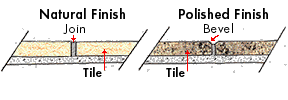
6. The fabricator and installer will deliver the stone and install it at the job site. Usually, fabricators and installers require payment, (in full), upon satisfactory installation.
VI. Care of stone
In order to keep your in perfect condition, it should be kept clean. The most common way to maintain stone is to brush away dust. Stone should be washed with a clean, soft cloth and fresh water. A mild detergent can be used periodically to remove any residue that remains ingrained. These steps will save many problems with stone. Some stone suppliers recommend applying a sealer on the stone a few weeks after installation is completed. This helps prevent staining on the stone. The sealer should be reapplied periodically since it wears off after an extended period of time.
In case of stains, the customer should contact a stone restorer for removal. (See form for fabricators)



